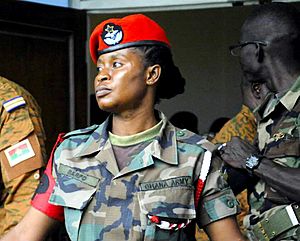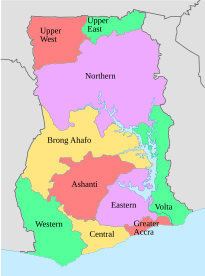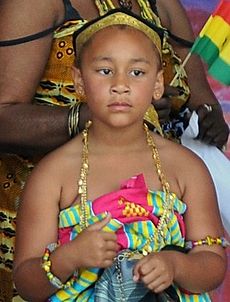Ghanaian people facts for kids

|
|
| Total population | |
|---|---|
| c. 30 million | |
| Regions with significant populations | |
| 10,000 (2010) | |
| 442,189 (2013) | |
| 116,807 (2011) | |
| 100,000+ (2015) | |
| 50,414 (2015) | |
| 40,000 (2003) | |
| 39,270 (2020) | |
| 35,495 (2016) | |
| 12,699 (2007) | |
| 10,297 (2013) | |
| 10,000 (2007) | |
| 5600 (2015) | |
| 3,866 (2011) | |
| 3,000 (2003) | |
| 2,424 (2014) | |
| 2,135 (2017) | |
| 1,754 (2009) | |
| 1,600 (2015) | |
| 533 (2011) | |
| 500 (2012) | |
| 277 (2007) | |
| 200 (2011) | |
| 90 | |
| Languages | |
|
|
| Religion | |
|
|
| Related ethnic groups | |
|
|
|
Ghanaian citizens or Ghanaian card nationals. |
|
The Ghanaian people are a nation from the area once known as the Ghanaian Gold Coast. Most Ghanaians live in the country of Ghana. They are the main cultural group and residents there. In 2013, about 20 million people lived in Ghana. The word "Ghana" means "warrior king."
About 20 million Ghanaians live in the Fourth Republic of Ghana. An extra 4 million people of Ghanaian background live in other countries. Ghana is rich in natural resources. It has large amounts of gold and sweet crude oil. It is also the world's second-largest producer of cocoa.
The Republic of Ghana is a strong economic country in West Africa. It has one of the biggest economies in Africa. It is also one of the world's fastest growing economies.
Contents
Ghana's History: From Nomads to Independence
The first Ghanaians were nomads who moved from Nubia. They traveled along the Sahara desert and then south to the Gold Coast. The Ghanaian people started forming their identity in this region between the 10th and 16th centuries AD.
Early Ghanaians traded gold and other minerals with the Portuguese starting in 1471. These Ghanaian states became very wealthy from the 17th century onwards. They expanded their gold trade to the Dutch, Prussians, and Scandinavians. This trade continued from the 16th century until the 20th century.
Ghanaians built many powerful kingdoms and empires from the 10th to the 17th century. Some of these became great powers in West Africa. By 1902, the United Kingdom had taken over these kingdoms. They became part of the Gold Coast colony after several conflicts in the 19th century.
Ghanaians became independent from British rule in 1957. They renamed their country "Ghana," meaning "Warrior King." This was because their kingdoms were known for being warrior societies. Ghana was the first African country to gain independence from European rule.
Ghana's Population and People
In 2013, Ghana had 20 million people. More than 90% of Ghanaians lived in cities. This is higher than the world average. Ghana's population grows at about the same rate as the world average.
Most Ghanaians move to cities to find good jobs. Ghanaians have a high level of education in many subjects. These include science, technology, math, and vocational skills. However, rural areas are important for growing food.
Who Are Ghanaian Citizens?
About 20 million people have Ghanaian passports. Another 3 to 4 million Ghanaians live abroad. Ghana has many different kinds of people. This shows its rich history. The main groups that formed Ghana's population are still important today.
Most of the population, 98%, are native West Africans. There are also people from Asia, the Middle East, and Europe. Other recent immigrants also live in Ghana.
To become a Ghanaian citizen, you usually need to live there for seven years. Many Asians, Middle Easterners, and Europeans have lived in Ghana for a long time. They have become Ghanaian citizens without any problems.
Languages Spoken in Ghana
About 67.1% of Ghanaians speak English. There are over 100 different ethnic groups in Ghana. Each group has its own language. However, languages from the same ethnic group are often similar enough to understand each other.
The government officially supports 11 languages from nine language families. These include Akuapem Twi, Asante Twi, Ewe, Fante, Ga, Dangme, Dagbani, Nzema, Dagaare, Gonja, and Kasena.
During the time of colonial rule, some Europeans married Africans. Their children included famous people like Carel Hendrik Bartels and James Bannerman. Most European settlers left Ghana after it became independent. Today, many immigrants in Ghana are from other African countries. There are also Asians (Indians and Chinese), some Europeans, and Middle Easterners.
Where Ghanaians Live: Cities and Regions
About 5% of Ghanaians live in rural areas. A large 95% live in cities. The number of people moving to cities is growing fast. Between 2010 and 2015, it grew by 4% each year. This is one of the highest rates among developing countries.
| Region (2010) | Region population | Area (km2) | City (2010) | City population | Administrative divisions of Ghana | |
|---|---|---|---|---|---|---|
| Ashanti Region | 4,780,380 | 24,389 | Kumasi | 1,989,062 | ||
| Brong-Ahafo Region | 2,310,983 | 39,557 | Sunyani | 87,642 | ||
| Central Region | 2,201,863 | 9,826 | Cape Coast | 217,032 | ||
| Eastern Region | 2,633,154 | 19,323 | Koforidua | 127,334 | ||
| Greater Accra Region | 4,010,054 | 3,245 | Accra | 2,291,352 | ||
| Northern Region | 2,479,461 | 70,384 | Tamale | 537,986 | ||
| Upper East Region | 1,046,545 | 8,842 | Bolgatanga | 66,68 | ||
| Upper West Region | 702,110 | 18,476 | Wa | 102,446 | ||
| Volta Region | 2,118,252 | 20,570 | Ho | 96,213 | ||
| Western Region | 2,376,021 | 23,921 | Sekondi-Takoradi | 445,205 | ||
|
|
24,658,823 | 238,533 | ||||
Different Groups of Ghanaians
Ghanaian Arabs
Ghanaian Arabs are citizens of Ghana who have Arab roots. They mostly come from Lebanon, Syria, and the Arab Maghreb region. Ghana has the largest Arab population in West Africa.
Ghanaian Indians
Ghanaian Indians are citizens of Ghana with Indian roots. Many of them are descendants of people who moved from India after India's partition in 1947.
White Ghanaians
White Ghanaians are citizens of Ghana, mostly with British roots. Some also have Dutch, French, German, Italian, Latin American, Polish, Portuguese, or Scandinavian backgrounds. About 3% of Ghana's population is white.
Ghanaians Around the World (Diaspora)
There are about 3 to 4 million Ghanaians living outside Ghana. This group is called the diaspora.
Ghanaian Australians
Ghanaian Australians are people who are citizens of both Australia and Ghana. They have Ghanaian roots. More than half of all Ghanaians born in Australia live in Sydney, New South Wales.
Ghanaian Americans
Ghanaian Americans are citizens of both America and Ghana. They have Ghanaian roots.
Ghanaian Canadians
Ghanaian Canadians are citizens of both Canada and Ghana. They have Ghanaian roots.
Ghanaian British
Ghanaian British are citizens of both Britain and Ghana. They have Ghanaian roots.
Ghanaian New Zealanders
Ghanaian New Zealanders are citizens of both New Zealand and Ghana. They have Ghanaian roots.
Ghanaian South Africans
Ghanaian South Africans are citizens of both South Africa and Ghana. They have Ghanaian roots.
Ghanaians in Suriname and Guyana
The Ndyuka people are a group of Akan Ghanaians. They live in eastern Suriname and western French Guiana. They speak the Ndyuka language, which is related to the Akan language. Their ancestors were brought from the Gold Coast (modern-day Ghana) to Suriname about 300 years ago. They worked as laborers on Dutch farms.
The Ndyukas are divided into two main groups. The Opu live upstream on the Tapanahony River in southeastern Suriname. The Bilo live downstream. They also have 14 family groups called lo, where family lines are traced through the mother.
Ghanaian Society and Culture
Ghana's culture is very diverse. You can see this in their food, art, books, music, dance, clothes, and sports.
Kente is a special Ghanaian cloth. It is often worn for ceremonies and is a national costume. Kente is hand-woven in strips about 4 inches wide. These strips are then sewn together to make larger pieces of cloth. Kente cloths come in many colors and designs. Each design has a different meaning. They are worn for important social events. In the 13th century, Ghanaians also created their unique adinkra printing art.
Famous Ghanaian writers include Ayi Kwei Armah and J. E. Casely Hayford. Besides novels, Ghana also has a strong tradition of theater and poetry.
Ghanaian music uses many different instruments. These include talking drums, the atenteben flute, and log xylophones. The most famous music style from Ghana is highlife. Highlife started in the late 1800s and early 1900s. In the 1990s, a new style called hiplife was created. It mixes highlife with Afro-reggae, dancehall, and hip hop. Hiplife is the most popular music in Ghana, followed by highlife.
Ghanaian dance is known worldwide. The dances involve complex movements of the arms, body, hips, feet, and head. They are performed to different Ghanaian music styles for fun, festivals, and other events. Popular dances include Adowa and Azonto. Other traditional dances are Kpanlogo, Klama, and Bamaya. Sports in Ghana are mostly about football (soccer). The main football league is the Ghana Premier League. Ghana also has a national football team.
A new festival called CHALEWOTE is held every year in James Town, Accra. It is celebrated with the Homowo festival. This festival helps people experience true Ghanaian culture.
Women in Ghana
In Ghanaian society, it was traditional for men to have more than one wife. This was especially common among wealthy men. In some groups, like the Akan, married women continued to live in their mothers' homes. The wife would bring meals to her husband at his mother's house. If a man had many wives, they would arrange visiting times. This way of living showed that each spouse followed the rules of their own family.
Today, having more than one wife is less common. In rural areas, about 23.9% of women are in such marriages. In cities, it's about 12.4%. This practice is most common among women aged 45–49. It becomes less common as women get more education and wealth.
From 2008 to 2012, about 83.2% of young women (15–24) could read and write. This was only a little lower than young men (88.3%). However, literacy rates change across different regions and wealth levels in Ghana. For women, literacy rates range from 44% to 81% depending on the region. Women with the highest wealth have the highest literacy rates at 85%. Only 31% of women with the lowest wealth can read and write.
More girls than boys were in preschool between 2008 and 2012. The number of girls and boys in primary school was about the same. About 84% were enrolled, and 73% attended. For secondary school, slightly fewer girls were enrolled than boys (44.4% vs. 48.1%). However, more girls attended than boys (39.7% vs. 43.6%).
As of 2011, women made up 66.9% of the working population in Ghana. In informal jobs, women often work in personal services. There are also differences in job training for women and men. Men can train for many jobs like carpenters, mechanics, and painters. Women mostly train as hairdressers or dressmakers. Women generally earn less than men. They earn an average of 6,280 cedis per day, while men earn 8,560 cedis. However, women are doing well in teaching jobs.

In the early 1990s, about 19% of university teachers were women. In other schools, women made up 20% of teaching staff in specialized schools, 21% in secondary schools, 23% in middle schools, and 42% in primary schools. Women also held many secretarial and nursing jobs. When women and men did the same work, they were paid equally. Women also received paid time off for maternity leave. However, women in research jobs reported more challenges than men. This might be because traditional family roles limit their professional connections.
Women's groups have grown in Ghana. They want women to have a stronger role in the government. In 2004, a group of women created the Women's Manifesto for Ghana. This document asks for equal economic and political rights. It also asks for health care and other rights for women. The National Council for Women and Development (NCWD) strongly believes that women's well-being is very important. Women make up more than half of Ghana's population. The Council has supported studies on women's work, education, and family issues. These studies help create policies to improve women's lives. The NCWD emphasizes family planning, child care, and female education as key areas.
In 2007, the Ghanaian government started legal actions to punish men who abuse women.
Ghana's Leaders Since Independence
In 1966, Kwame Nkrumah was removed from power. After that, Ghana was ruled by the military for a time. On December 31, 1981, Flight lieutenant Jerry John Rawlings took control. He set up the Provisional National Defence Council (PNDC) and became its chairman.
In 1992, Rawlings left the military. He then started a political party called the National Democratic Congress (NDC). He was elected president twice.
In 2002, John Agyekum Kufuor became Ghana's head of state. He served until 2008. John Atta Mills then became head of state until 2012. In 2013, John Dramani Mahama became the President of Ghana. He also became the Commander-in-Chief of the Ghana Armed Forces.




